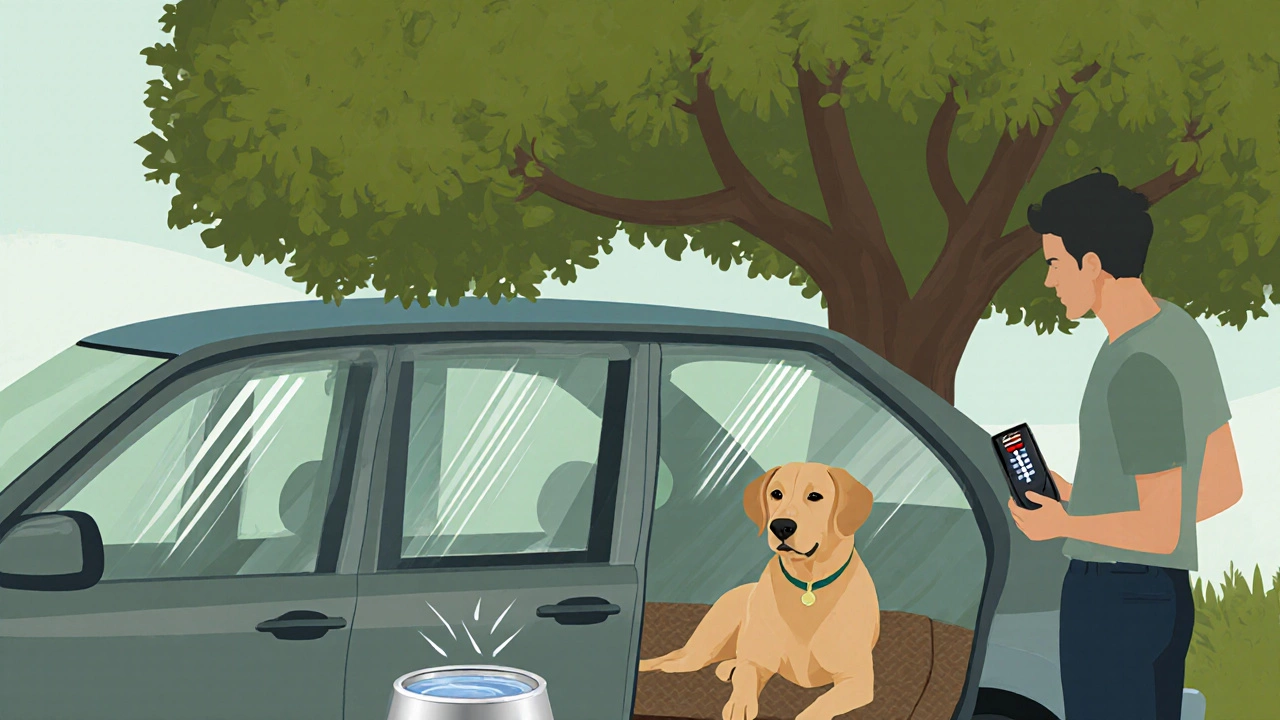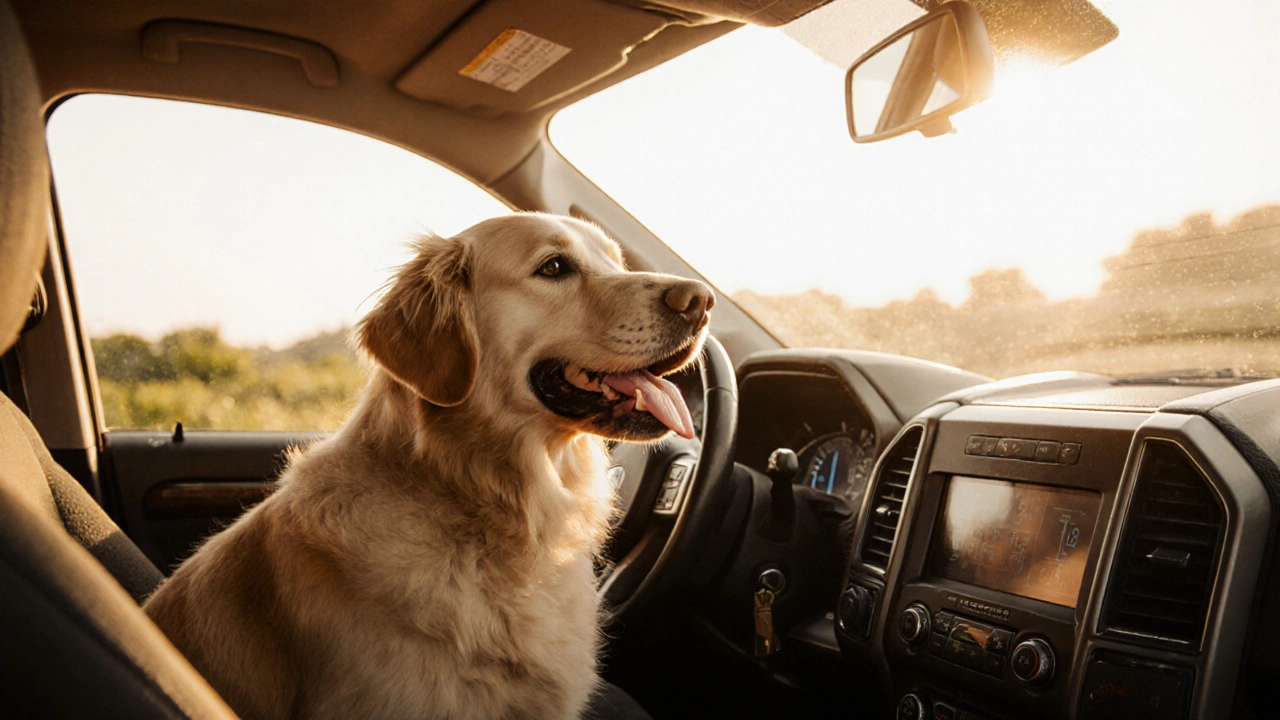Dog Car Safety Calculator
This tool estimates how quickly a car heats up and whether it's safe to leave your dog inside based on key factors from veterinary research.
Important Safety Note
The American Veterinary Medical Association recommends never leaving a dog unattended in a vehicle when the outside temperature exceeds 70°F (21°C). Even at 70°F, temperatures can reach 120°F (49°C) within 30 minutes due to the greenhouse effect.
Cracked windows provide minimal ventilation - less than 10% airflow. Always prioritize your dog's safety over convenience.
Wondering if you can leave your dog in a car? The answer isn’t simple- it depends on the weather, the law in your state, and how long you plan to be away. Below you’ll find the facts you need to keep your pup safe and avoid costly fines.
Key Takeaways
- Most states treat leaving a dog in a hot car as animal cruelty.
- Even on a mild day, a vehicle’s interior can reach dangerous temperatures quickly.
- Never rely on cracked windows for ventilation; fresh air flow is minimal.
- Use a pet temperature sensor or shade the car if you must step out.
- Know the signs of heatstroke and act fast.
When it comes to asking dog in car safety, the conversation usually starts with the question “Can I leave my dog in the car?” Below we break down the legal backdrop, the health risks, and the practical steps you can take.
Legal Landscape Across the U.S.
Each state has its own wording, but the trend is clear: leaving a dog unattended in a vehicle under unsafe conditions is illegal in most places.
State animal cruelty law is a set of statutes that define neglect, abuse, and cruelty toward animals. In 45 states, these laws specifically mention the danger of leaving pets in hot cars, treating it as a misdemeanor with fines ranging from $250 to $5,000.
The American Veterinary Medical Association (AVMA) has published a position statement urging lawmakers to adopt clear temperature‑based standards. Many states have followed that cue, setting a threshold of 85°F (29°C) for the interior temperature of a parked vehicle before it’s considered a violation.
Even in states without explicit language, prosecutors can still cite general cruelty statutes. The safest bet is to assume that any situation where a dog could suffer heat‑related injury is illegal.
Health Risks: Why Temperature Matters
Dogs don’t sweat the way humans do. They cool themselves mainly through panting and by releasing a small amount of moisture through their paw pads. That makes them especially vulnerable when the air inside a car heats up.
Heatstroke is a life‑threatening condition that occurs when a dog’s core temperature rises above 105°F (40.5°C). Symptoms include rapid breathing, bright red gums, drooling, lethargy, and in severe cases, seizures or unconsciousness.
Research from the University of Georgia (2023) showed that a vehicle left in direct sunlight can reach 120°F (49°C) within 30 minutes, even when the outside temperature is only 70°F (21°C). Small breeds, brachycephalic dogs (like Bulldogs and Pugs), and puppies are at higher risk because they have less efficient cooling mechanisms.

Factors That Influence Risk
Not all cars or climates are the same. Here are the main variables that decide how quickly the interior heats up:
- Sun exposure: Cars parked in direct sunlight heat up faster than those in shade.
- Vehicle color: Dark‑colored cars absorb more heat.
- Window opening: Cracking a window an inch or two provides only about 10% more airflow; it’s rarely enough.
- Dog breed and size: Short‑nosed and tiny dogs overheat quicker.
- Seasonal humidity: High humidity reduces a dog’s ability to evaporate moisture through panting.
Vehicle interior temperature rises dramatically when the sun hits the windshield, creating a greenhouse effect that traps heat inside the car’s cabin.
Practical Tips to Keep Your Dog Safe
If you absolutely must step out of the car for a brief moment, follow these guidelines:
- Check the temperature first: Use a pet temperature sensor (available on most pet‑friendly retail sites) to monitor the cabin’s heat. If it reads above 85°F (29°C), stay with your dog.
- Park in the shade: Look for a tree‑covered spot or a covered parking lot.
- Leave windows slightly open: If you must open a window, keep it at least two inches for better airflow.
- Provide water: A spill‑proof water bowl can help, but remember it can also tip over and create a mess.
- Never leave the car for more than a few minutes: Even 5 minutes can be risky on hot days.
For longer errands, consider pet‑friendly alternatives like a nearby dog‑friendly café, a trusted neighbor, or a professional pet‑sitting service.

What to Do If Your Dog Shows Signs of Distress
If you notice rapid panting, drooling, or a change in behavior, act immediately:
- Pull over safely and open all doors.
- Offer cool (not icy) water.
- Apply cool, damp towels to the neck, armpits, and groin.
- Drive (or walk) to the nearest veterinary clinic. Explain the situation, as many vets have protocols for heatstroke.
- After treatment, consider a follow‑up blood test to check for organ damage.
Time is critical- heatstroke can cause irreversible damage within an hour.
Alternatives to Leaving Your Dog in the Car
Instead of risking legal trouble and health hazards, try one of these options:
- Dog‑friendly stores: Many big‑box retailers now allow pets inside.
- Pet‑care centers: A short‑term boarding service can watch your dog while you shop.
- Bring a friend: A companion can sit with the dog in a shaded outdoor area.
- Use a travel crate: If you must drive somewhere, keep the crate in a well‑ventilated, temperature‑controlled vehicle.
These solutions keep both you and your dog out of danger and protect you from potential fines.
Frequently Asked Questions
Is it ever legal to leave a dog in a parked car?
Only if the interior temperature stays below the legal threshold (usually 85°F/29°C) and the dog can access water and ventilation. In practice, that rarely happens, especially on sunny days.
How quickly does a car heat up?
A car parked in direct sun can rise to 120°F (49°C) within 30 minutes, even when the outside temperature is 70°F (21°C). Dark colors and larger windows accelerate the process.
What breeds are most at risk?
Brachycephalic breeds like Bulldogs, Pugs, and Shih Tzus, as well as small dogs and puppies, overheat faster because they have limited airflow and smaller body mass.
Can I use a car’s air‑conditioning while I’m inside?
If the car is running with the AC on, the interior stays cooler, but many jurisdictions still consider it unsafe to leave a dog unattended for any length of time.
What should I do if my dog has a heatstroke emergency?
Move the dog to a cool shaded area, offer water, apply damp towels to major blood vessels, and get to a vet immediately. Time is vital; delay can be fatal.

